-
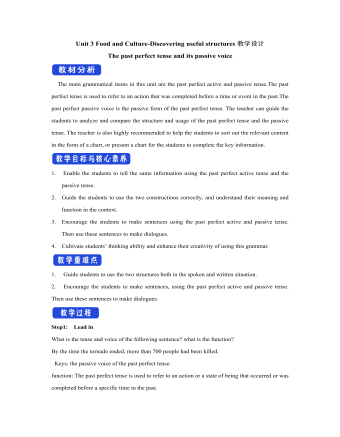
新人教版高中英语选修2Unit 3 Food and Culture-Discovering useful structures教学设计
The newspaper reported more than 100 people had been killed in the thunderstorm.报纸报道说有一百多人在暴风雨中丧生。(2)before、when、by the time、until、after、once等引导的时间状语从句的谓语是一般过去时,以及by、before后面接过去的时间时,主句动作发生在从句的动作或过去的时间之前且表示被动时,要用过去完成时的被动语态。By the time my brother was 10, he had been sent to Italy.我弟弟10岁前就已经被送到意大利了。Tons of rice had been produced by the end of last month. 到上月底已生产了好几吨大米。(3) It was the first/second/last ... time that ...句中that引导的定语从句中,主语与谓语构成被动关系时,要用过去完成时的被动语态。It was the first time that I had seen the night fact to face in one and a half years. 这是我一年半以来第一次亲眼目睹夜晚的景色。(4)在虚拟语气中,条件句表示与过去事实相反,且主语与谓语构成被动关系时,要用过去完成时的被动语态。If I had been instructed by him earlier, I would have finished the task.如果我早一点得到他的指示,我早就完成这项任务了。If I had hurried, I wouldn't have missed the train.如果我快点的话,我就不会误了火车。If you had been at the party, you would have met him. 如果你去了晚会,你就会见到他的。
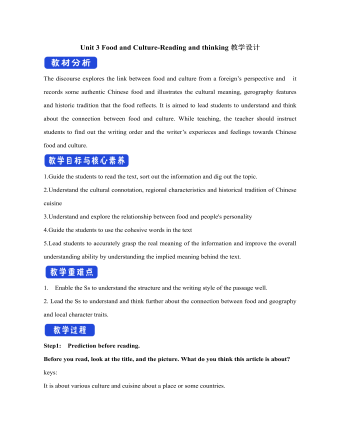
新人教版高中英语选修2Unit 3 Food and Culture-Reading and thinking教学设计
The discourse explores the link between food and culture from a foreign’s perspective and it records some authentic Chinese food and illustrates the cultural meaning, gerography features and historic tradition that the food reflects. It is aimed to lead students to understand and think about the connection between food and culture. While teaching, the teacher should instruct students to find out the writing order and the writer’s experieces and feelings towards Chinese food and culture.1.Guide the students to read the text, sort out the information and dig out the topic.2.Understand the cultural connotation, regional characteristics and historical tradition of Chinese cuisine3.Understand and explore the relationship between food and people's personality4.Guide the students to use the cohesive words in the text5.Lead students to accurately grasp the real meaning of the information and improve the overall understanding ability by understanding the implied meaning behind the text.1. Enable the Ss to understand the structure and the writing style of the passage well.2. Lead the Ss to understand and think further about the connection between food and geography and local character traits.Step1: Prediction before reading. Before you read, look at the title, and the picture. What do you think this article is about?keys:It is about various culture and cuisine about a place or some countries.
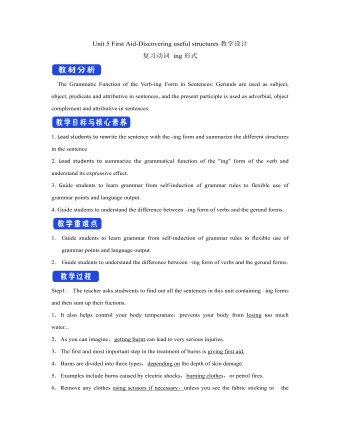
新人教版高中英语选修2Unit 5 First Aid-Discovering useful structures教学设计
You have no excuse for not going.你没有理由不去。He was punished for not having finished his homework.他因未完成作业而受到惩罚。2.动词ing形式复合结构由物主代词或人称代词宾格、名词所有格或普通格加动词ing,即“sb./sb.'s+doing”构成。动词ing形式的复合结构实际上是给动词ing形式加了一个逻辑主语。动词ing形式的复合结构有四种形式:①形容词性物主代词+动词ing②名词所有格+动词ing③代词宾格+动词ing④名词+动词ingHer coming to help encouraged all of us.她来帮忙鼓舞了我们所有人。The baby was made awake by the door suddenly shutting.这个婴儿被突然的关门声吵醒了。Can you imagine him/Jack cooking at home?你能想象他/杰克在家做饭的样子吗?无生命名词无论是作主语还是作宾语都不能用第②种形式。Tom's winning first prize last year impressed me a lot.汤姆去年得了一等奖使我印象深刻。Do you mind my/me/Jack's/Jack leaving now?你介意我/杰克现在离开吗?Excuse me for my not coming on time.很抱歉我没能按时来。His father's being ill made him worried.他父亲病了,他很担心。We are looking forward to the singer's/the singer to give us a concert.我们盼望着这位歌手来给我们举办一场演唱会。
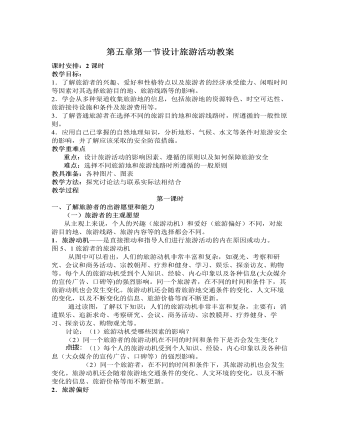
人教版高中地理选修3第五章第一节设计旅游活动教案
点拨:旅游地旅游资源的特色不同,可以安排的旅游活动是不一样的,直接影响对旅游者的吸引力。因此,出游前首先就需要收集旅游地旅游资源的类型、主要游览景区、景点的特色等情况。旅游地的时空可达性直接关系到旅游者从出发地到旅游地,然后再返回出发地的费用和时间。一般来说,居住地与旅游地之间的空间距离过大,会使旅行的时间过长、旅行费用过高,经济距离增加,相应地降低了旅游者的出游能力。而居住地与旅游地相距遥远,也意味着两地之间巨大的环境差异,这会增加对游客的吸引力。旅游服务设施和条件,如旅游交通方式及工具、旅游住宿条件、旅游餐饮的种类和标准、导游服务、旅行费用等信息也都在一定程度上影响着游客的选择。图5.3西藏布达拉宫和图5.4云南香格里拉两幅图片显示了西藏布达拉宫、云南香格里拉与众不同的优美景观,吸引了众多的游客前来观光旅游,成为近年来国内旅游的热点。
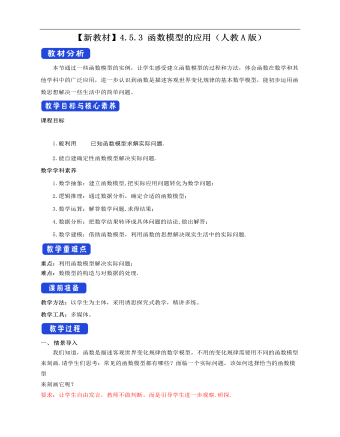
人教A版高中数学必修一函数模型的应用教学设计(2)
本节通过一些函数模型的实例,让学生感受建立函数模型的过程和方法,体会函数在数学和其他学科中的广泛应用,进一步认识到函数是描述客观世界变化规律的基本数学模型,能初步运用函数思想解决一些生活中的简单问题。课程目标1.能利用已知函数模型求解实际问题.2.能自建确定性函数模型解决实际问题.数学学科素养1.数学抽象:建立函数模型,把实际应用问题转化为数学问题;2.逻辑推理:通过数据分析,确定合适的函数模型;3.数学运算:解答数学问题,求得结果;4.数据分析:把数学结果转译成具体问题的结论,做出解答;5.数学建模:借助函数模型,利用函数的思想解决现实生活中的实际问题.重点:利用函数模型解决实际问题;难点:数模型的构造与对数据的处理.
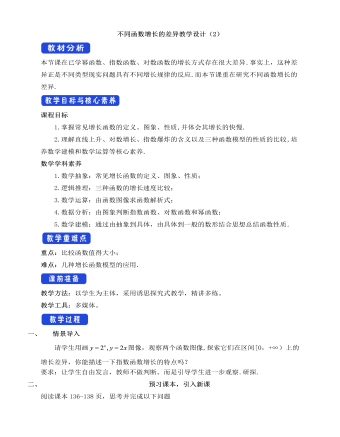
人教A版高中数学必修一不同函数增长的差异教学设计(2)
本节课在已学幂函数、指数函数、对数函数的增长方式存在很大差异.事实上,这种差异正是不同类型现实问题具有不同增长规律的反应.而本节课重在研究不同函数增长的差异.课程目标1.掌握常见增长函数的定义、图象、性质,并体会其增长的快慢.2.理解直线上升、对数增长、指数爆炸的含义以及三种函数模型的性质的比较,培养数学建模和数学运算等核心素养.数学学科素养1.数学抽象:常见增长函数的定义、图象、性质;2.逻辑推理:三种函数的增长速度比较;3.数学运算:由函数图像求函数解析式;4.数据分析:由图象判断指数函数、对数函数和幂函数;5.数学建模:通过由抽象到具体,由具体到一般的数形结合思想总结函数性质.重点:比较函数值得大小;难点:几种增长函数模型的应用.教学方法:以学生为主体,采用诱思探究式教学,精讲多练。教学工具:多媒体。
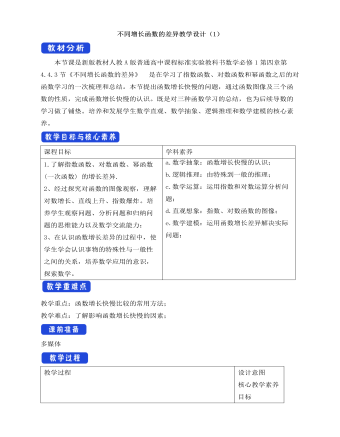
人教A版高中数学必修一不同增长函数的差异教学设计(1)
本节课是新版教材人教A版普通高中课程标准实验教科书数学必修1第四章第4.4.3节《不同增长函数的差异》 是在学习了指数函数、对数函数和幂函数之后的对函数学习的一次梳理和总结。本节提出函数增长快慢的问题,通过函数图像及三个函数的性质,完成函数增长快慢的认识。既是对三种函数学习的总结,也为后续导数的学习做了铺垫。培养和发展学生数学直观、数学抽象、逻辑推理和数学建模的核心素养。1.了解指数函数、对数函数、幂函数 (一次函数) 的增长差异.2、经过探究对函数的图像观察,理解对数增长、直线上升、指数爆炸。培养学生观察问题、分析问题和归纳问题的思维能力以及数学交流能力;3、在认识函数增长差异的过程中,使学生学会认识事物的特殊性与一般性之间的关系,培养数学应用的意识,探索数学。 a.数学抽象:函数增长快慢的认识;b.逻辑推理:由特殊到一般的推理;
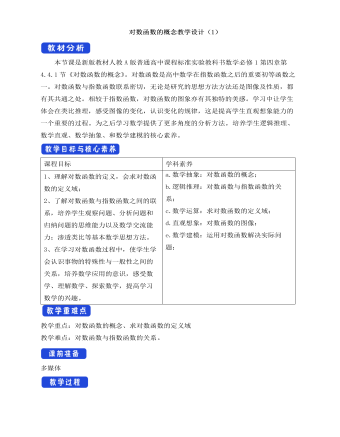
人教A版高中数学必修一对数函数的概念教学设计(1)
本节课是新版教材人教A版普通高中课程标准实验教科书数学必修1第四章第4.4.1节《对数函数的概念》。对数函数是高中数学在指数函数之后的重要初等函数之一。对数函数与指数函数联系密切,无论是研究的思想方法方法还是图像及性质,都有其共通之处。相较于指数函数,对数函数的图象亦有其独特的美感。学习中让学生体会在类比推理,感受图像的变化,认识变化的规律,这是提高学生直观想象能力的一个重要的过程。为之后学习数学提供了更多角度的分析方法。培养学生逻辑推理、数学直观、数学抽象、和数学建模的核心素养。1、理解对数函数的定义,会求对数函数的定义域;2、了解对数函数与指数函数之间的联系,培养学生观察问题、分析问题和归纳问题的思维能力以及数学交流能力;渗透类比等基本数学思想方法。3、在学习对数函数过程中,使学生学会认识事物的特殊性与一般性之间的关系,培养数学应用的意识,感受数学、理解数学、探索数学,提高学习数学的兴趣。
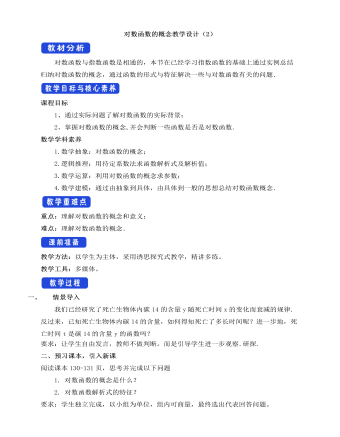
人教A版高中数学必修一对数函数的概念教学设计(2)
对数函数与指数函数是相通的,本节在已经学习指数函数的基础上通过实例总结归纳对数函数的概念,通过函数的形式与特征解决一些与对数函数有关的问题.课程目标1、通过实际问题了解对数函数的实际背景;2、掌握对数函数的概念,并会判断一些函数是否是对数函数. 数学学科素养1.数学抽象:对数函数的概念;2.逻辑推理:用待定系数法求函数解析式及解析值;3.数学运算:利用对数函数的概念求参数;4.数学建模:通过由抽象到具体,由具体到一般的思想总结对数函数概念.重点:理解对数函数的概念和意义;难点:理解对数函数的概念.教学方法:以学生为主体,采用诱思探究式教学,精讲多练。教学工具:多媒体。一、 情景导入我们已经研究了死亡生物体内碳14的含量y随死亡时间x的变化而衰减的规律.反过来,已知死亡生物体内碳14的含量,如何得知死亡了多长时间呢?进一步地,死亡时间t是碳14的含量y的函数吗?
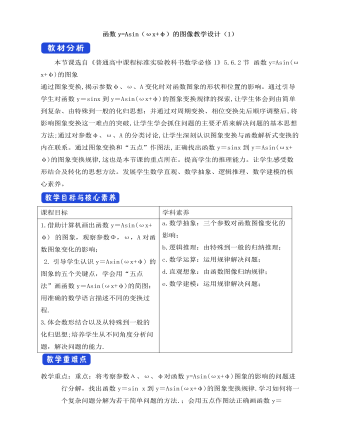
人教A版高中数学必修一函数y=Asin(ωχ+φ)教学设计(1)
本节课选自《普通高中课程标准实验教科书数学必修1》5.6.2节 函数y=Asin(ωx+φ)的图象通过图象变换,揭示参数φ、ω、A变化时对函数图象的形状和位置的影响。通过引导学生对函数y=sinx到y=Asin(ωx+φ)的图象变换规律的探索,让学生体会到由简单到复杂、由特殊到一般的化归思想;并通过对周期变换、相位变换先后顺序调整后,将影响图象变换这一难点的突破,让学生学会抓住问题的主要矛盾来解决问题的基本思想方法;通过对参数φ、ω、A的分类讨论,让学生深刻认识图象变换与函数解析式变换的内在联系。通过图象变换和“五点”作图法,正确找出函数y=sinx到y=Asin(ωx+φ)的图象变换规律,这也是本节课的重点所在。提高学生的推理能力。让学生感受数形结合及转化的思想方法。发展学生数学直观、数学抽象、逻辑推理、数学建模的核心素养。
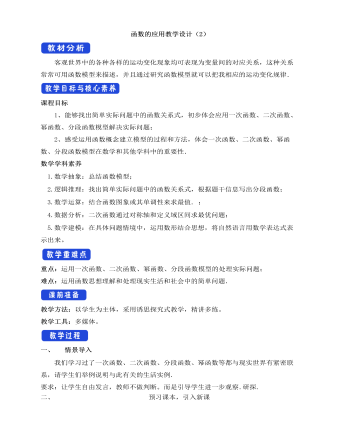
人教A版高中数学必修一函数的应用(一)教学设计(2)
客观世界中的各种各样的运动变化现象均可表现为变量间的对应关系,这种关系常常可用函数模型来描述,并且通过研究函数模型就可以把我相应的运动变化规律.课程目标1、能够找出简单实际问题中的函数关系式,初步体会应用一次函数、二次函数、幂函数、分段函数模型解决实际问题; 2、感受运用函数概念建立模型的过程和方法,体会一次函数、二次函数、幂函数、分段函数模型在数学和其他学科中的重要性. 数学学科素养1.数学抽象:总结函数模型; 2.逻辑推理:找出简单实际问题中的函数关系式,根据题干信息写出分段函数; 3.数学运算:结合函数图象或其单调性来求最值. ; 4.数据分析:二次函数通过对称轴和定义域区间求最优问题; 5.数学建模:在具体问题情境中,运用数形结合思想,将自然语言用数学表达式表示出来。 重点:运用一次函数、二次函数、幂函数、分段函数模型的处理实际问题;难点:运用函数思想理解和处理现实生活和社会中的简单问题.
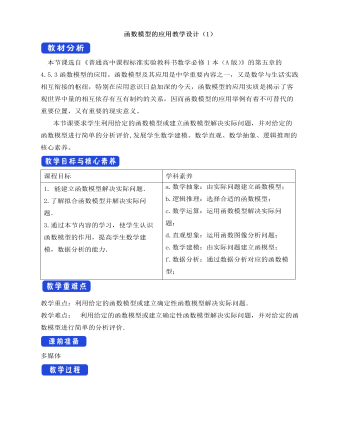
人教A版高中数学必修一函数模型的应用教学设计(1)
本节课选自《普通高中课程标准实验教科书数学必修1本(A版)》的第五章的4.5.3函数模型的应用。函数模型及其应用是中学重要内容之一,又是数学与生活实践相互衔接的枢纽,特别在应用意识日益加深的今天,函数模型的应用实质是揭示了客观世界中量的相互依存有互有制约的关系,因而函数模型的应用举例有着不可替代的重要位置,又有重要的现实意义。本节课要求学生利用给定的函数模型或建立函数模型解决实际问题,并对给定的函数模型进行简单的分析评价,发展学生数学建模、数学直观、数学抽象、逻辑推理的核心素养。1. 能建立函数模型解决实际问题.2.了解拟合函数模型并解决实际问题.3.通过本节内容的学习,使学生认识函数模型的作用,提高学生数学建模,数据分析的能力. a.数学抽象:由实际问题建立函数模型;b.逻辑推理:选择合适的函数模型;c.数学运算:运用函数模型解决实际问题;

人教A版高中数学必修一集合的基本运算教学设计(1)
本节是新人教A版高中数学必修1第1章第1节第3部分的内容。在此之前,学生已学习了集合的含义以及集合与集合之间的基本关系,这为学习本节内容打下了基础。本节内容主要介绍集合的基本运算一并集、交集、补集。是对集合基木知识的深入研究。在此,通过适当的问题情境,使学生感受、认识并掌握集合的三种基本运算。本节内容是函数、方程、不等式的基础,在教材中起着承上启下的作用。本节内容是高中数学的主要内容,也是高考的对象,在实践中应用广泛,是高中学生必须掌握的重点。A.理解两个集合的并集与交集的含义,会求简单集合的交、并运算;B.理解补集的含义,会求给定子集的补集;C.能使用 图表示集合的关系及运算。 1.数学抽象:集合交集、并集、补集的含义;2.数学运算:集合的运算;3.直观想象:用 图、数轴表示集合的关系及运算。

人教A版高中数学必修一集合的基本运算教学设计(2)
集合的基本运算是人教版普通高中课程标准实验教科书,数学必修1第一章第三节的内容. 在此之前,学生已学习了集合的含义以及集合与集合之间的基本关系,这为学习本节内容打下了基础. 本节内容是函数、方程、不等式的基础,在教材中起着承上启下的作用. 本节内容是高中数学的主要内容,也是高考的对象,在实践中应用广泛,是高中学生必须掌握的重点.课程目标1. 理解两个集合的并集与交集的含义,能求两个集合的并集与交集;2. 理解全集和补集的含义,能求给定集合的补集; 3. 能使用Venn图表达集合的基本关系与基本运算.数学学科素养1.数学抽象:并集、交集、全集、补集含义的理解;2.逻辑推理:并集、交集及补集的性质的推导;3.数学运算:求 两个集合的并集、交集及补集,已知并集、交集及补集的性质求参数(参数的范围);4.数据分析:通过并集、交集及补集的性质列不等式组,此过程中重点关注端点是否含“=”及?问题;
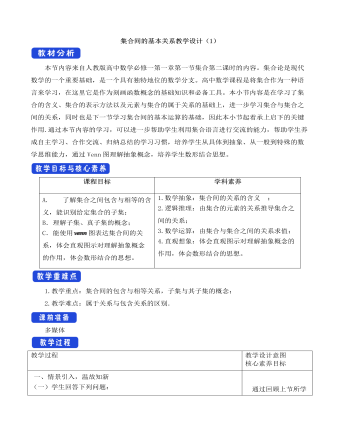
人教A版高中数学必修一集合间的基本关系教学设计(1)
本节内容来自人教版高中数学必修一第一章第一节集合第二课时的内容。集合论是现代数学的一个重要基础,是一个具有独特地位的数学分支。高中数学课程是将集合作为一种语言来学习,在这里它是作为刻画函数概念的基础知识和必备工具。本小节内容是在学习了集合的含义、集合的表示方法以及元素与集合的属于关系的基础上,进一步学习集合与集合之间的关系,同时也是下一节学习集合间的基本运算的基础,因此本小节起着承上启下的关键作用.通过本节内容的学习,可以进一步帮助学生利用集合语言进行交流的能力,帮助学生养成自主学习、合作交流、归纳总结的学习习惯,培养学生从具体到抽象、从一般到特殊的数学思维能力,通过Venn图理解抽象概念,培养学生数形结合思想。

人教A版高中数学必修一简单的三角恒等变换教学设计(1)
四、小结1.知识:如何采用两角和或差的正余弦公式进行合角,借助三角函数的相关性质求值.其中三角函数最值问题是对三角函数的概念、图像和性质,以及诱导公式、同角三角函数基本关系、和(差)角公式的综合应用,也是函数思想的具体体现. 如何科学的把实际问题转化成数学问题,如何选择自变量建立数学关系式;求解三角函数在某一区间的最值问题.2.思想:本节课通过由特殊到一般方式把关系式 化成 的形式,可以很好地培养学生探究、归纳、类比的能力. 通过探究如何选择自变量建立数学关系式,可以很好地培养学生分析问题、解决问题的能力和应用意识,进一步培养学生的建模意识.五、作业1. 课时练 2. 预习下节课内容学生根据课堂学习,自主总结知识要点,及运用的思想方法。注意总结自己在学习中的易错点;

人教A版高中数学必修一集合间的基本关系教学设计(2)
第一节通过研究集合中元素的特点研究了元素与集合之间的关系及集合的表示方法,而本节重点通过研究元素得到两个集合之间的关系,尤其学生学完两个集合之间的关系后,一定让学生明确元素与集合、集合与集合之间的区别。课程目标1. 了解集合之间包含与相等的含义,能识别给定集合的子集.2. 理解子集.真子集的概念. 3. 能使用 图表达集合间的关系,体会直观图示对理解抽象概念的作用。数学学科素养1.数学抽象:子集和空集含义的理解;2.逻辑推理:子集、真子集、空集之间的联系与区别;3.数学运算:由集合间的关系求参数的范围,常见包含一元二次方程及其不等式和不等式组;4.数据分析:通过集合关系列不等式组, 此过程中重点关注端点是否含“=”及 问题;5.数学建模:用集合思想对实际生活中的对象进行判断与归类。

人教A版高中数学必修一简单的三角恒等变换教学设计(2)
它位于三角函数与数学变换的结合点上,能较好反应三角函数及变换之间的内在联系和相互转换,本节课内容的地位体现在它的基础性上。作用体现在它的工具性上。前面学生已经掌握了两角和与差的正弦、余弦、正切公式以及二倍角公式,并能通过这些公式进行求值、化简、证明,虽然学生已经具备了一定的推理、运算能力,但在数学的应用意识与应用能力方面尚需进一步培养.课程目标1.能用二倍角公式推导出半角公式,体会三角恒等变换的基本思想方法,以及进行简单的应用. 2.了解三角恒等变换的特点、变换技巧,掌握三角恒等变换的基本思想方法. 3.能利用三角恒等变换的技巧进行三角函数式的化简、求值以及证明,进而进行简单的应用. 数学学科素养1.逻辑推理: 三角恒等式的证明; 2.数据分析:三角函数式的化简; 3.数学运算:三角函数式的求值.

人教A版高中数学必修一同角三角函数的基本关系教学设计(2)
本节内容是学生学习了任意角和弧度制,任意角的三角函数后,安排的一节继续深入学习内容,是求三角函数值、化简三角函数式、证明三角恒等式的基本工具,是整个三角函数知识的基础,在教材中起承上启下的作用。同时,它体现的数学思想与方法在整个中学数学学习中起重要作用。课程目标1.理解并掌握同角三角函数基本关系式的推导及应用.2.会利用同角三角函数的基本关系式进行化简、求值与恒等式证明.数学学科素养1.数学抽象:理解同角三角函数基本关系式;2.逻辑推理: “sin α±cos α”同“sin αcos α”间的关系;3.数学运算:利用同角三角函数的基本关系式进行化简、求值与恒等式证明重点:理解并掌握同角三角函数基本关系式的推导及应用; 难点:会利用同角三角函数的基本关系式进行化简、求值与恒等式证明.
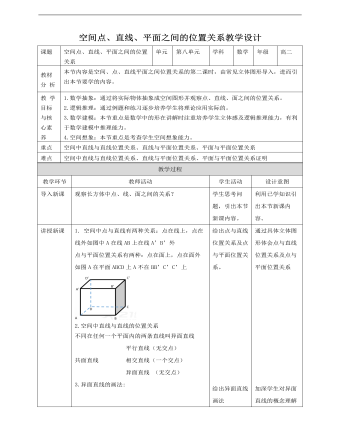
人教A版高中数学必修二空间点、直线、平面之间的位置关系教学设计
9.例二:如图,AB∩α=B,A?α, ?a.直线AB与a具有怎样的位置关系?为什么?解:直线AB与a是异面直线。理由如下:若直线AB与a不是异面直线,则它们相交或平行,设它们确定的平面为β,则B∈β, 由于经过点B与直线a有且仅有一个平面α,因此平面平面α与β重合,从而 , 进而A∈α,这与A?α矛盾。所以直线AB与a是异面直线。补充说明:例二告诉我们一种判断异面直线的方法:与一个平面相交的直线和这个平面内不经过交点的直线是异面直线。10. 例3 已知a,b,c是三条直线,如果a与b是异面直线,b与c是异面直线,那么a与c有怎样的位置关系?并画图说明.解: 直线a与直线c的位置关系可以是平行、相交、异面.如图(1)(2)(3).总结:判定两条直线是异面直线的方法(1)定义法:由定义判断两条直线不可能在同一平面内.

